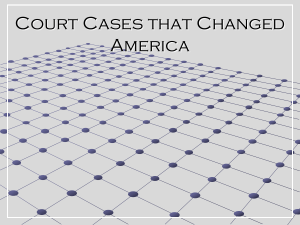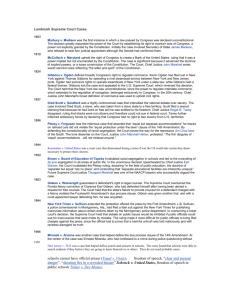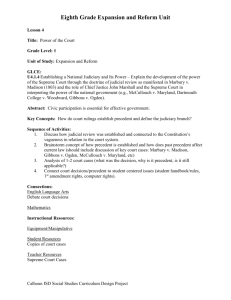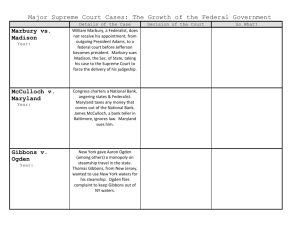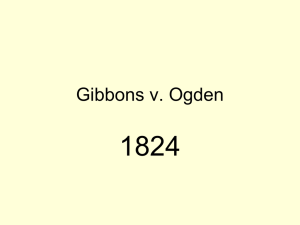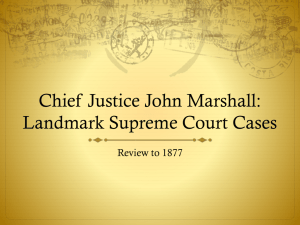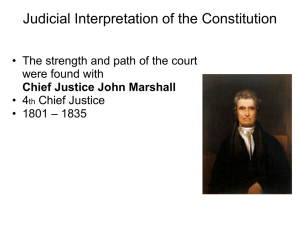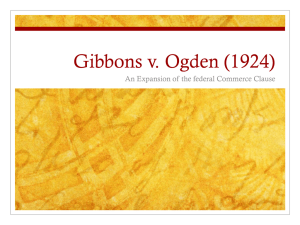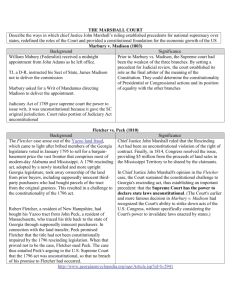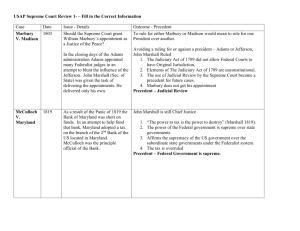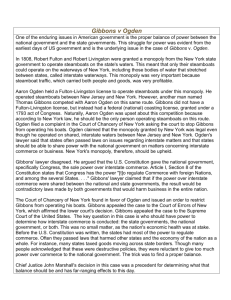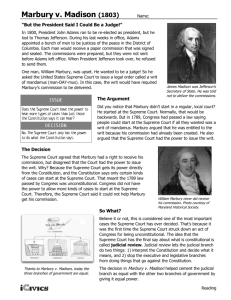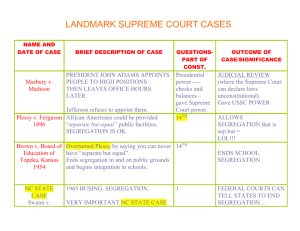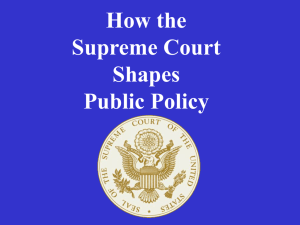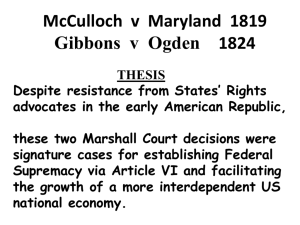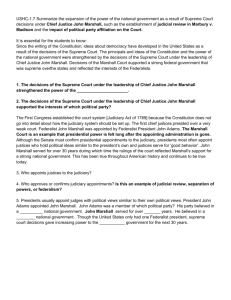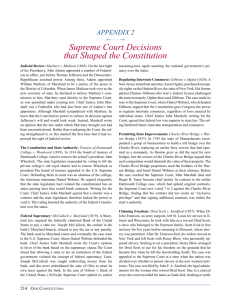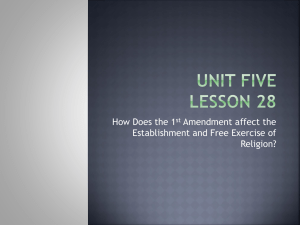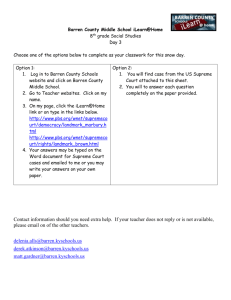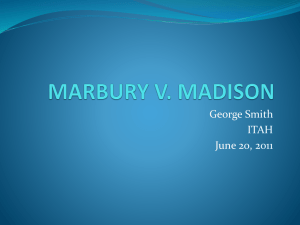Supreme Court Cases: Establishing Federal Supremacy
advertisement
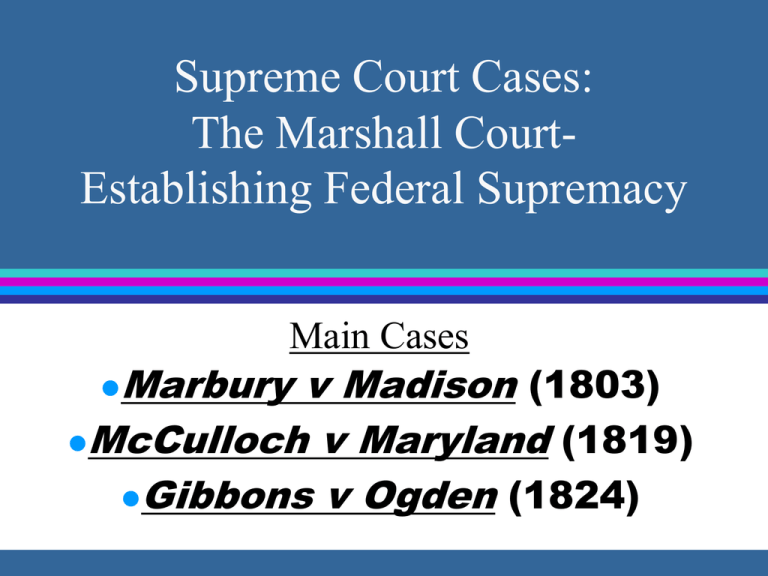
Supreme Court Cases: The Marshall CourtEstablishing Federal Supremacy Main Cases Marbury v Madison (1803) McCulloch v Maryland (1819) Gibbons v Ogden (1824) Judiciary Act of 1789 1789 law that created the Judicial Branch of the federal government. Things provided for in the Act: the number of members of the Supreme Court (6) the number of lower district courts (13) the idea that the Supreme Court can settle disputes between states the idea that a decision by the Supreme Court is final. Judiciary Act of 1801 Gave the President the power to appoint more federal judges. Marbury v Madison (1803) Historical Context -In November 1800, Federalist President John Adams lost his re-election bid to Anti-Federalist Thomas Jefferson. - Last minute, Adams appointed several Federalist federal judges who were then approved by the Senate. -Knowing this, when Jefferson became President, he ordered Sec. Of State James Madison not to deliver the commission to William Marbury -Marbury sued Madison in an attempt to gain his post. -Marbury asked the Supreme Court to rule on the case Issue Whether Marbury deserved the Commission Whether the Supreme Court could remedy his problem Decision -The Supreme Court and James Marshall found that the Judiciary Act was unconstitutional because it gave the powers to the SC and the Constitution does not give Congress the power to do that -Established the precedent that the SC has the final say on all laws (Judicial Review) -Winner: John Marshall-strengthened the power of the SC Legacy of Marbury Case Established Judicial Review More Power to Judicial Branch Marshall Court: Strengthen the power of the federal government McCulloch v Maryland (1819) Historical Context -The state of Maryland brought an action against James McCulloch, a cashier in the Maryland branch of the Bank of the United States, for not paying a tax the State had imposed on the US Bank. Issue: Whether the state of Maryland had the right to tax a federal agency which was properly set up by the US Congress. Decision: The Court ruled that the “power to tax is the power to destroy” and that the federal government’s bank was immune to state taxation. The Court reasoned that Congress could set up a bank and write laws “necessary and proper” according to its constitutional power to coin and regulate money. Other Significant Cases of the Marshall Court Gibbons v Ogden (1824)- SC established broad interpretation of the federal government’s authority over interstate commerce The Case Aaron Ogden filed a complaint in the Court of Chancery of New York asking the court to restrain Thomas Gibbons from operating on these waters. Ogden's lawyer contended that states often passed laws on issues regarding interstate matters and that states should have fully concurrent power with Congress on matters concerning interstate commerce. Gibbons' lawyer, Daniel Webster, argued that Congress had exclusive national power over interstate commerce according to Article I, Section 8 of the Constitution and that to argue otherwise would result in confusing and contradictory local regulatory policies. The Court of Chancery of New York and the Court of Errors of New York found in favor of Ogden and issued an injunction to restrict Gibbons from operating his boats. Gibbons appealed the case to the Supreme Court, which reversed the decision. The Decision The decision called Gibbons's federal license a legitimate exercise of the regulation of commerce provided in Article I, Section 8 of the Constitution. The New York State law creating a commercial monopoly was therefore void, since it conflicted with the regulatory power of the Federal Government in the performance of its constitutional responsibilities. The Court ruled that Gibbons must be allowed to operate within the waters of New York State. Dred Scott v Sanford (1757) Historical Context • Dredd Scott was a slave who forever changed the definition of property. He went with his master to Illinois and Minnesota and claimed that this made him a free man. The Missouri Supreme Court found otherwise. Scott, sued his new owner, John Sanford of New York, for damages, alleging physical abuse. A federal court ruled that Scott was a citizen. But the Supreme Court ruled otherwise. Chief Justice Roger Taney, in an 1857 plurality opinion, said that AfricanAmericans could never become United States citizens and that the Missouri Compromise was unconstitutional. Further, the Court said, Congress could not constitutionally exclude slavery from the territories. Issue Since the Missouri Compromise outlawed slavery in newly established territories and Scott moved with his owner to Minnesota, he was then considered a free man. The SC ruled against Scott stating that property does not have rights therefore Scott’s claims of abuse were not valid Decision The Supreme Court ruled otherwise. Chief Justice Roger Taney, in an 1857 said that African-Americans could never become United States citizens and that the Missouri Compromise was unconstitutional. Further, the Court said, Congress could not constitutionally exclude slavery from the territories. Review Questions What did Marbury v Madison establish? What powers were strengthened by Marshall Court decisions?
